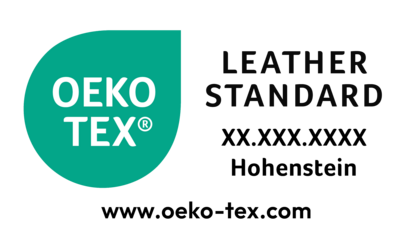
What is LEATHER STANDARD?
OEKO-TEX® LEATHER STANDARD is a globally standardised, independent testing and certification system for leather products at all processing levels, and their accessories. LEATHER STANDARD certification provides targeted product stewardship support for companies in the leather chain with human-ecological product safety, based on a scientific criteria catalogue and neutral laboratory tests. For consumers and purchasers, the LEATHER STANDARD product label is reliable proof that items made of leather are tested in accordance with strict global standards to protect from harmful substances.
Together with OEKO-TEX® STeP certification for environmentally friendly and socially responsible production facilities, LEATHER STANDARD forms the basis for granting the OEKO-TEX® MADE IN GREEN label for leather articles.
Further specifications
The concept of the OEKO-TEX® LEATHER STANDARD tests for harmful substances is based on a modular system. This means that certification is available for every stage of the leather value creation chain, and that certificates from prior stages are recognised at subsequent stages of processing without further testing.
The LEATHER STANDARD certificate and label are only issued if all components of an article successfully comply with the stipulated criteria, including not only the outer material, but also all sewing threads, linings or coatings, as well as accessories such as buttons or zippers.
LEATHER STANDARD tests for harmful substances are based on the product's intended purpose. The more intensive the skin contact and the more sensitive the skin, the stricter the human-ecological requirements. Accordingly, LEATHER STANDARD distinguishes between four product classes:
- Product class I:
Leather items and materials for babies and toddlers through age three: leather clothing, leather gloves, sheepskin baby blankets, furs, and so on - Product class II:
Products used in close contact with skin: leather trousers/jackets, leather gloves, leather hats and so on - Product class III:
Products used away from the skin: lined leather jackets/coats, leather bags, leather belts, and so on - Product class IV:
Furnishing materials: upholstery covers, and so on
How can LEATHER STANDARD support you?
With LEATHER STANDARD certification, you ensure legal conformity of your products in all important consumer markets. At the same time, the LEATHER STANDARD product label gives you an ideal instrument for marketing your leather articles, due to its globally high recognition and prevalence. Last but not least, LEATHER STANDARD simplifies and accelerates supplier relationships for manufacturers and retailers who want to ensure product safety for their customers.
Basic facts
Validity
A LEATHER STANDARD certificate is valid for 12 months and can be renewed annually. We recommend starting the renewal process up to three months before expiration to ensure continuous product safety and smooth process along the modular OEKO-TEX® system. Many downstream certifications are dependent on pre-certified components from suppliers.
Target group
Any manufacturer or reseller of leather materials or finished goods - from any stage of processing - throughout the value chain.
Criteria / Requirements
The OEKO-TEX® LEATHER STANDARD criteria catalogue contains a wide variety of test parameters and is updated annually, based on latest scientific findings, changes to industry initiatives and market developments.
In many cases, the test criteria and limit values go far beyond legal requirements. The inclusion of numerous additional potentially harmful substances strongly reflects the pioneering role that the LEATHER STANDARD has played so far.
The LEATHER STANDARD laboratory tests for harmful substances include:
- Substances which are prohibited and regulated by law
- Chemicals that are known to be harmful to health but which are not regulated by law
- Substances that are believed to be harmful to health
Certification process
- Application
The applicant completes the application form and provides representative product samples for testing. - Testing
We create an individual testing plan for your application request, test the provided samples in our labs and send you a detailed test report. - Declaration of Conformity / Quality Assurance System
If your submitted product samples meet the required LEATHER STANDARD criteria, you have to sign a declaration of conformity that the products from your current production comply with the tested sample materials. Additionally, you have to provide proof that you have a quality assurance system in place that ensures the human-ecological quality of your products throughout the entire term of the issued certificate. - On-site audit
During an on-site audit at your premises, our OEKO-TEX® experts will confirm all the certification details. The audit may be either before or shortly after the certification is finished. - Certificate
We will issue certificate to you which allows you to mark and advertise your leather products with the LEATHER STANDARD label.
Your benefits at a glance
- LEATHER STANDARD is a practical tool for your quality assurance.
- Consumer protection with leather products that are safe for human ecology and legally compliant - without expending internal resources.
- The OEKO-TEX® criteria catalogue is applied consistently worldwide and provides standardised requirements for purchasing and delivery, thus simplifying and accelerating the flow of information.
- The modular principle of LEATHER STANDARD facilitates testing and certification of leather items at every processing stage. Duplicate testing costs are avoided by using certificates from prior stages – even for products with complex structures.
- The greater transparency increases product safety, especially for companies with extremely short production cycles and expensive internal quality assurance systems, and provides significant time-savings.
- As a third-party verified label, LEATHER STANDARD is a recognised marketing tool for transparently promoting product stewardship efforts
- Many retailers and brands have Restricted Substances Lists (RSLs) based on LEATHER STANDARD and accept certification in lieu of additional testing.
- Marketing opportunities in the OEKO-TEX® Buying Guide and external listings such as Foursource.
Downloads
Application Forms & Standard specifications
Supporting documents
- Checklist Certification - OEKO-TEX® STANDARD 100 / LEATHER STANDARDpdf
- Checklist Material Quantities & Sample Sizes - OEKO-TEX® STANDARD 100 / LEATHER STANDARD / ORGANIC COTTONpdf
- Testing Methods - OEKO-TEX® LEATHER STANDARDpdf
- Factsheet - OEKO-TEX® LEATHER STANDARDpdf
- Brochure - OEKO-TEX® LEATHER STANDARDpdf
